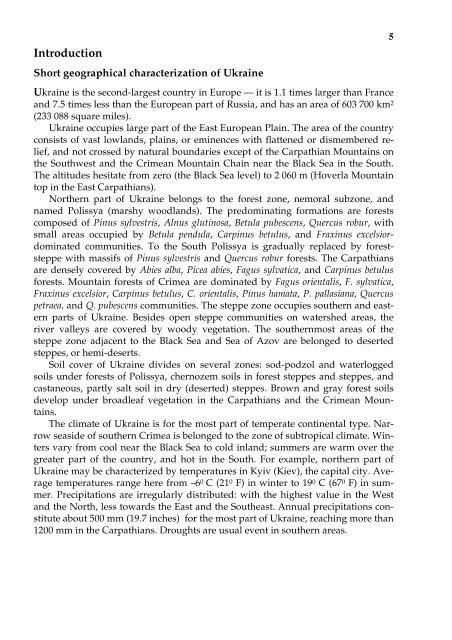Annotated checklist of aphyllophoroid fungi of Ukraine
Annotated checklist of aphyllophoroid fungi of Ukraine
Annotated checklist of aphyllophoroid fungi of Ukraine
You also want an ePaper? Increase the reach of your titles
YUMPU automatically turns print PDFs into web optimized ePapers that Google loves.
Introduction<br />
Short geographical characterization <strong>of</strong> <strong>Ukraine</strong><br />
<strong>Ukraine</strong> is the second-largest country in Europe — it is 1.1 times larger than France<br />
and 7.5 times less than the European part <strong>of</strong> Russia, and has an area <strong>of</strong> 603 700 km 2<br />
(233 088 square miles).<br />
<strong>Ukraine</strong> occupies large part <strong>of</strong> the East European Plain. The area <strong>of</strong> the country<br />
consists <strong>of</strong> vast lowlands, plains, or eminences with flattened or dismembered relief,<br />
and not crossed by natural boundaries except <strong>of</strong> the Carpathian Mountains on<br />
the Southwest and the Crimean Mountain Chain near the Black Sea in the South.<br />
The altitudes hesitate from zero (the Black Sea level) to 2 060 m (Hoverla Mountain<br />
top in the East Carpathians).<br />
Northern part <strong>of</strong> <strong>Ukraine</strong> belongs to the forest zone, nemoral subzone, and<br />
named Polissya (marshy woodlands). The predominating formations are forests<br />
composed <strong>of</strong> Pinus sylvestris, Alnus glutinosa, Betula pubescens, Quercus robur, with<br />
small areas occupied by Betula pendula, Carpinus betulus, and Fraxinus excelsiordominated<br />
communities. To the South Polissya is gradually replaced by foreststeppe<br />
with massifs <strong>of</strong> Pinus sylvestris and Quercus robur forests. The Carpathians<br />
are densely covered by Abies alba, Picea abies, Fagus sylvatica, and Carpinus betulus<br />
forests. Mountain forests <strong>of</strong> Crimea are dominated by Fagus orientalis, F. sylvatica,<br />
Fraxinus excelsior, Carpinus betulus, C. orientalis, Pinus hamata, P. pallasiana, Quercus<br />
petraea, and Q. pubescens communities. The steppe zone occupies southern and eastern<br />
parts <strong>of</strong> <strong>Ukraine</strong>. Besides open steppe communities on watershed areas, the<br />
river valleys are covered by woody vegetation. The southernmost areas <strong>of</strong> the<br />
steppe zone adjacent to the Black Sea and Sea <strong>of</strong> Azov are belonged to deserted<br />
steppes, or hemi-deserts.<br />
Soil cover <strong>of</strong> <strong>Ukraine</strong> divides on several zones: sod-podzol and waterlogged<br />
soils under forests <strong>of</strong> Polissya, chernozem soils in forest steppes and steppes, and<br />
castaneous, partly salt soil in dry (deserted) steppes. Brown and gray forest soils<br />
develop under broadleaf vegetation in the Carpathians and the Crimean Mountains.<br />
The climate <strong>of</strong> <strong>Ukraine</strong> is for the most part <strong>of</strong> temperate continental type. Narrow<br />
seaside <strong>of</strong> southern Crimea is belonged to the zone <strong>of</strong> subtropical climate. Winters<br />
vary from cool near the Black Sea to cold inland; summers are warm over the<br />
greater part <strong>of</strong> the country, and hot in the South. For example, northern part <strong>of</strong><br />
<strong>Ukraine</strong> may be characterized by temperatures in Kyiv (Kiev), the capital city. Average<br />
temperatures range here from –6 0 C (21 0 F) in winter to 19 0 C (67 0 F) in summer.<br />
Precipitations are irregularly distributed: with the highest value in the West<br />
and the North, less towards the East and the Southeast. Annual precipitations constitute<br />
about 500 mm (19.7 inches) for the most part <strong>of</strong> <strong>Ukraine</strong>, reaching more than<br />
1200 mm in the Carpathians. Droughts are usual event in southern areas.<br />
5



